
Agrotis ipsilon, the dark sword-grass, black cutworm, greasy cutworm, floodplain cutworm or ipsilon dart, is a small noctuid moth found worldwide. The moth gets its scientific name from black markings on its forewings shaped like the letter "Y" or the Greek letter upsilon. The larvae are known as "cutworms" because they cut plants and other crops. The larvae are serious agricultural pests and feed on nearly all varieties of vegetables and many important grains.
Prosodarma is a genus of moth in the family Gelechiidae. It contains the species Prosodarma fibularis, which is found in Indonesia.
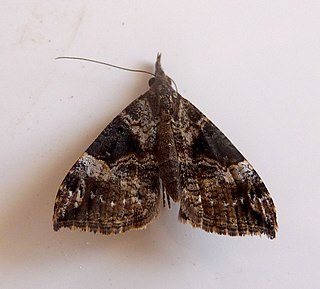
Hypena obsitalis, the Bloxworth snout, is a moth of the family Erebidae. It is found in the Mediterranean Basin including North Africa and in the Near East and Middle East, south up to the Sahara. Further north it is a migrant which occasionally establishes.

Adela croesella is a moth of the family Adelidae. It is found in most of Europe.
Hexadactilia civilis is a moth of the family Pterophoridae. It is found in Queensland, Australia.

Izatha metadelta is a moth of the family Oecophoridae. It is endemic to New Zealand, where it is known from the North Island only. It is rare north of Waikato and the Bay of Plenty.

Ochsenheimeria urella is a moth of the family Ypsolophidae. It is found in large parts of Europe, except the Iberian Peninsula, most of the Balkan Peninsula, Ukraine and Lithuania.

Pectinivalva scotodes is a moth of the family Nepticulidae. It is found in New South Wales and southern Queensland.
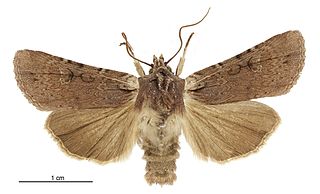
Ichneutica omoplaca is a moth of the family Noctuidae. It is endemic to New Zealand. It is widespread from the Bay of Plenty in the North Island down to Southland in the South Island. Specimens have also been collected from the Auckland Islands. It lives in a variety of habitats including beech forest clearings and tussock grasslands. This species has been recorded that some of the larval hosts of this species include Poa cita, Dactylis glomerata and it has been reared on Plantago lanceolata. The larva is undescribed but pupae have been found in a pine plantation in soil under weeds. Adults of this species are on the wing from October to March. The adult moths are variable in appearance but the diagnostic feature is the pale ochreous to white colouring between the basal streak and the costa which contrasts with the ground colour of the forewing.
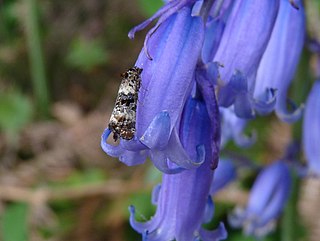
Hysterophora maculosana, the bluebell conch, is a species of moth of the family Tortricidae. It is found from most of Europe, east to the Crimea, Asia Minor and the Palestinian territories. The habitat consists of woodland areas.
Molopostola calumnias is a moth in the family Gelechiidae. It was described by Edward Meyrick in 1926. It is found in Brazil.
Antaeotricha dromica is a species of moth of the family Depressariidae. It is found in Brazil (Para).
Dinotropa ochrocrossa is a moth of the family Depressariidae and the only species in the genus Dinotropa. It is found in French Guiana.
Frisilia notifica is a moth in the family Lecithoceridae. It was described by Edward Meyrick in 1910. It is found in Sri Lanka.
Epichostis antigama is a moth in the family Xyloryctidae. It was described by Edward Meyrick in 1908. It is found in southern India.
Epichostis tympanias is a moth in the family Xyloryctidae. It was described by Edward Meyrick in 1908. It is found in Assam, India.
Antaeotricha protosaris is a moth in the family Depressariidae. It was described by Edward Meyrick in 1915. It is found in the Guianas and Brazil.

Pammene argyrana is a species of moth belonging to the family Tortricidae.
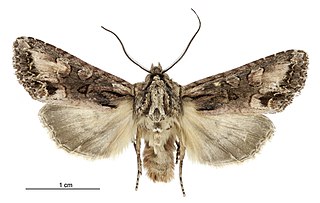
Ichneutica bromias is a moth of the family Noctuidae. This species is endemic to the Chatham Islands of New Zealand where is found on the Chatham, Pitt and Rangatira Islands. This species is similar in appearance to Ichneutica mutans but is darker and duller in its overall appearance. However, as I. mutans is not present in the Chathams this similarity is unlikely to cause confusion. The adults of the species are on the wing from November to March. The life history and the larval host species are unknown.
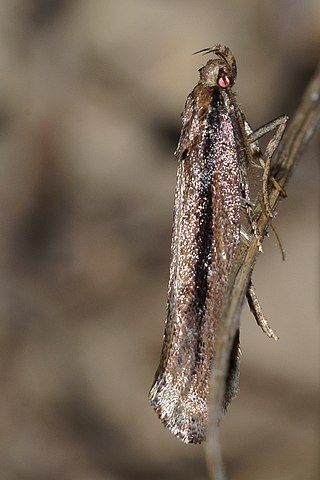
Atomotricha versuta is a moth in the family Oecophoridae first described by Edward Meyrick in 1914. It is endemic to New Zealand and has been observed in both the North and South Islands. The adults of the species are variable in appearance but the three principal variteis are connected b intermediate forms. The female of the species is brachypterous and is incapable of flight. Both the adult male and female have been observed resting on fences during cold winter nights.










